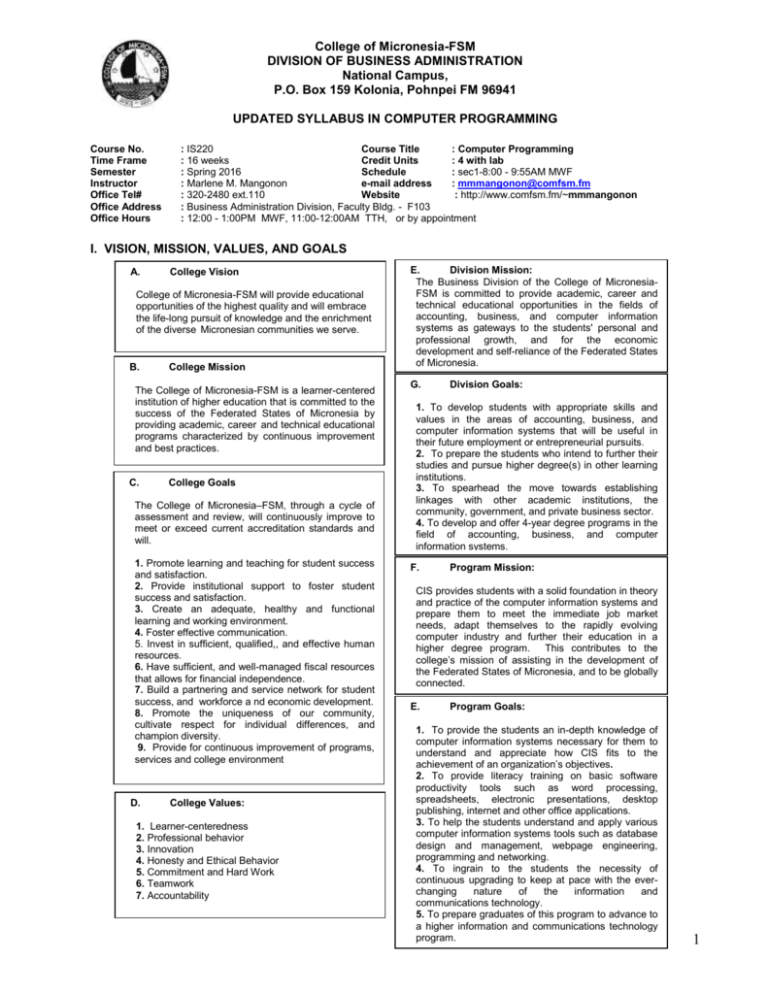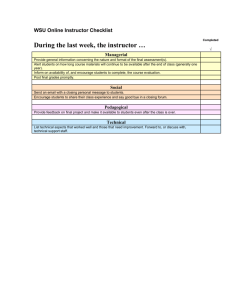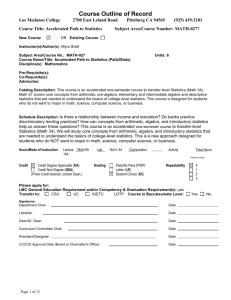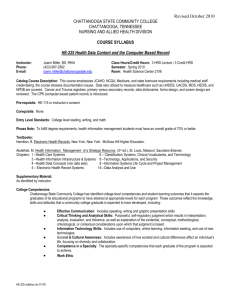
College of Micronesia-FSM
DIVISION OF BUSINESS ADMINISTRATION
National Campus,
P.O. Box 159 Kolonia, Pohnpei FM 96941
UPDATED SYLLABUS IN COMPUTER PROGRAMMING
Course No.
Time Frame
Semester
Instructor
Office Tel#
Office Address
Office Hours
: IS220
Course Title
: Computer Programming
: 16 weeks
Credit Units
: 4 with lab
: Spring 2016
Schedule
: sec1-8:00 - 9:55AM MWF
: Marlene M. Mangonon
e-mail address
: mmmangonon@comfsm.fm
: 320-2480 ext.110
Website
: http://www.comfsm.fm/~mmmangonon
: Business Administration Division, Faculty Bldg. - F103
: 12:00 - 1:00PM MWF, 11:00-12:00AM TTH, or by appointment
I. VISION, MISSION, VALUES, AND GOALS
A.
College Vision
College of Micronesia-FSM will provide educational
opportunities of the highest quality and will embrace
the life-long pursuit of knowledge and the enrichment
of the diverse Micronesian communities we serve.
B.
College Mission
The College of Micronesia-FSM is a learner-centered
institution of higher education that is committed to the
success of the Federated States of Micronesia by
providing academic, career and technical educational
programs characterized by continuous improvement
and best practices.
C.
College Goals
The College of Micronesia–FSM, through a cycle of
assessment and review, will continuously improve to
meet or exceed current accreditation standards and
will.
1. Promote learning and teaching for student success
and satisfaction.
2. Provide institutional support to foster student
success and satisfaction.
3. Create an adequate, healthy and functional
learning and working environment.
4. Foster effective communication.
5. Invest in sufficient, qualified,, and effective human
resources.
6. Have sufficient, and well-managed fiscal resources
that allows for financial independence.
7. Build a partnering and service network for student
success, and workforce a nd economic development.
8. Promote the uniqueness of our community,
cultivate respect for individual differences, and
champion diversity.
9. Provide for continuous improvement of programs,
services and college environment
D.
College Values:
1. Learner-centeredness
2. Professional behavior
3. Innovation
4. Honesty and Ethical Behavior
5. Commitment and Hard Work
6. Teamwork
7. Accountability
E.
Division Mission:
The Business Division of the College of MicronesiaFSM is committed to provide academic, career and
technical educational opportunities in the fields of
accounting, business, and computer information
systems as gateways to the students' personal and
professional growth, and for the economic
development and self-reliance of the Federated States
of Micronesia.
G.
Division Goals:
1. To develop students with appropriate skills and
values in the areas of accounting, business, and
computer information systems that will be useful in
their future employment or entrepreneurial pursuits.
2. To prepare the students who intend to further their
studies and pursue higher degree(s) in other learning
institutions.
3. To spearhead the move towards establishing
linkages with other academic institutions, the
community, government, and private business sector.
4. To develop and offer 4-year degree programs in the
field of accounting, business, and computer
information systems.
F.
Program Mission:
CIS provides students with a solid foundation in theory
and practice of the computer information systems and
prepare them to meet the immediate job market
needs, adapt themselves to the rapidly evolving
computer industry and further their education in a
higher degree program. This contributes to the
college’s mission of assisting in the development of
the Federated States of Micronesia, and to be globally
connected.
E.
Program Goals:
1. To provide the students an in-depth knowledge of
computer information systems necessary for them to
understand and appreciate how CIS fits to the
achievement of an organization’s objectives.
2. To provide literacy training on basic software
productivity tools such as word processing,
spreadsheets, electronic presentations, desktop
publishing, internet and other office applications.
3. To help the students understand and apply various
computer information systems tools such as database
design and management, webpage engineering,
programming and networking.
4. To ingrain to the students the necessity of
continuous upgrading to keep at pace with the everchanging
nature
of
the
information
and
communications technology.
5. To prepare graduates of this program to advance to
a higher information and communications technology
program.
1
II. INSTITUTIONAL AND PROGRAM LEARNING OUTCOMES:
Institutional Learning Outcomes:
Program Learning Outcomes:
COM-FSM graduates will demonstrate:
1. Demonstrate an in-depth understanding of technical
concepts and ethical issues pertaining to information
systems
2. Demonstrate theoretical knowledge and practical
skills in the management and strategic use of
information systems and technology.
3. Demonstrate proficiency in the use of different
software applications significant to manipulating and
analyzing information as well as generating and
presenting reports in the various functional areas of
business.
4. Demonstrate solid foundation skills in database
design and management, web engineering,
programming, and networking;
5. Demonstrate the ability to adapt to latest technologies
using their foundation knowledge and skills from CIS.
1.
Effective oral communication;
2.
Effective written communication;
3.
Critical thinking;
4.
Problem solving;
5.
Intercultural knowledge and competence;
6.
Information literacy;
7.
Foundations and skills for life-long learning, and
8.
Quantitative reasoning.
III. COURSE DESCRIPTION
This course provides an introduction to programming using one of the high-level programming languages. The
course aims at presenting basic programming concepts and then a series of hands-on, step-by-step activities to reinforce
learning through practical applications in the business environment.
IV. COURSE OUTCOMES
General:
Upon successful completion of this course, student will be able to:
1.
2.
Explain computer programming concepts
Demonstrate project(program) development skills
Specific:
Upon successful completion of this course, student will be able to exhibit knowledge and skills respectively in:
CSLO (General) 1: Explain computer programming concepts; and
Student Learning Outcome (specific)
ISLO
1.1 Describe the features and benefits of prevalent
7
programming languages.
1.2 Describe the general phases of program development,
including planning, coding, compiling, linking, and
debugging.
7
1.3 Explain the three types of basic instructions – input,
process, and output.
7
1.4 Identify the programming tools- flowcharts, pseudocode,
hierarchy chart, and documentation basics.
7
1.5 Identify and describe the purpose of constants,
variables, operators, and functions.
7
1.6 Explain the purpose of general functionality provided by
conditional statements/control structures, relational
operators, and logical operators.
7
1.7 Explain the purpose of general functionality provided by
loops statements/repetition structures.
7
1.8 Explain the benefits of dividing large programming tasks
to smaller tasks.
7
PSLO Assessment Strategies
4 To assess CSLO_1.1, the instructor will use an essay exam.
The student will describe the features and benefits of
prevalent programming languages.
4 To assess CSLO _1.2, the instructor will use an essay
exam. The student will describe the general phases of
program development, including planning, coding, compiling,
linking, and debugging.
4 To assess CSLO _1.3, the instructor will use an essay
exam. The student will explain the three types of basic
instructions – input, process, and output.
4 To assess CSLO _1.4, the instructor will use an essay
exam. The student will identify the programming toolsflowcharts, pseudocode, hierarchy chart, and documentation
basics
4 To assess CSLO _1.5, the instructor will use an essay
exam. The student will identify and describe the purpose of
constants, variables, operators, and functions.
4 To assess CSLO _1.6, the instructor will use an essay
exam. The student will explain the purpose of general
functionality provided by conditional statements/control
structures, relational operators, and logical operators.
4 To assess CSLO _1.7, the instructor will use an essay
exam. The student will explain the purpose of general
functionality provided by loops statements/repetition
structures.
4 To assess CSLO _1.8, the instructor will use an exam. The
student will explain the benefits of dividing large
2
1.9 Explain the concept of arrays.
7
4
programming tasks to smaller tasks.
To assess CSLO _1.9, the instructor will use an essay
exam. Student will explain the concept of arrays.
CSLO (General) 2: Demonstrate project(program) development skills.
Student Learning Outcome (specific)
ISLO PSLO Assessment Strategies
2.1 Develop programs using the top-down approach.
4, *7
4 To assess CSLO _2.1, the instructor will use hands-on case
project. The student will demonstrate program development
skills using the top-down approach.
2.2 Construct programs using conditional statements/control 4,7
4 To assess CSLO _2.2, the instructor will use hands-on case
structures.
project. The student will demonstrate program development
skills using conditional statements/control structures.
2.3 Construct programs using loops statements/ repetition
4,7
4 To assess CSLO _2.3, the instructor will use hands-on case
structures.
project. The student will demonstrate program development
skills using loops statements/ repetition structures.
2.4 Construct programs using subroutines and functions.
4,7
4 To assess CSLO _2.4, the instructor will use hands-on case
project. The student will demonstrate program development
skills using subroutines, and functions.
2.5 Construct programs processing arrays.
4,7
4 To assess CSLO _2.5, the instructor will use hands-on case
project. The student will demonstrate program development
skills in processing arrays.
2.6. Demonstrate knowledge of debugging techniques and
4,7
4 To assess CSLO _2.6, the instructor will use hands-on case
diagnostic methods for correcting errors.
project. The student will demonstrate knowledge of
debugging techniques and diagnostic methods for correcting
errors.
V. COURSE REQUIREMENTS
Laboratory Activities (Hand-on Projects)
Quizzes
Midterm and Final Exam
Attendance
VI. COURSE CONTENT
1.
Introduction to Programming
a. Types of Programming Languages
b. Programming Development Cycle
c. Programming Tools: Algorithm, Flowchart,
Hierarchy Chart
Modular Design
4.
General Procedures
a. Sub Procedures
b. Function Procedures
c. Modular Design
2.
Fundamentals of Basic Programming
a. Constants
b. Variables
c. Expressions
5.
Repetition Statements
a. Pre-test loops
b. Post-test loops
6.
3.
Statements Decision Statements
a. Relational and logical operators
b. If Block statement
c. Select Case block statement
Array
1. One Dimensional Array
2. Multi-Dimensional Array
7.
Introduction to Object Oriented Programming(OOP)
VII. METHODS AND INSTRUCTION
1.
2.
3.
Hands-on Skills Development in programming
PowerPoint Presentation
Individual Projects
VIII. GRADING CRITERIA
4.
Lab Activities –
Quizzes –
Midterm Exam –
FINAL PROJECT Total Points
50%
20%
10%
20%
____________
100%
Grades will be assigned based on the following
percentage of total points received
homework/assignments, recitation/ oral presentation,
quizzes, mid-term exam, final exam, and attendance:
A,… ………………..90% to 100%
B., …… ……………80% to 89%
C….……………….70% to 79%
D….. ……………….60% to 69%
F……………………59% and below
3
Students are required to attend the class during scheduled class time. A maximum of 6 absences in an MWF class and 4 absences in a
TTH class can be allowed during the semester. The total missed classes include unexcused and excused, such as sickness, funerals,
and any other circumstances. A student exceeding the maximum limit of absences will be withdrawn from the class by the instructor
without prior notice to the student. Latecomers will be marked tardy and three(3) tardiness during MWF and two(2) tardiness during TTH
classes will be counted as one absence. Official class attendance sheet will be passed for signature before lesson discussions start.
Names without affixed signatures will be considered absent. Therefore, it is the responsibility of the student to make sure that he/she
signs the official class attendance sheet.
Homework, assignments, and projects must be turned in on time, regardless of attendance. No quizzes or exams can be
made up without a valid medical excuse.
VIII. TEXTBOOK(S)/REFERENCE(S)
Savitch, W. (2012). Problem solving with C++ (8th ed.). Boston: Pearson/Addison-Wesley.
IX. REQUIRED COURSE MATERIALS
Storage Medium (e.g. external drive, thumb drive, etc.)
X. ACADEMIC HONESTY POLICY
The COM-FSM Academic Policy applies to this course
Prepared by: MARLENE M. MANGONON
Business/CIS Instructor
4









